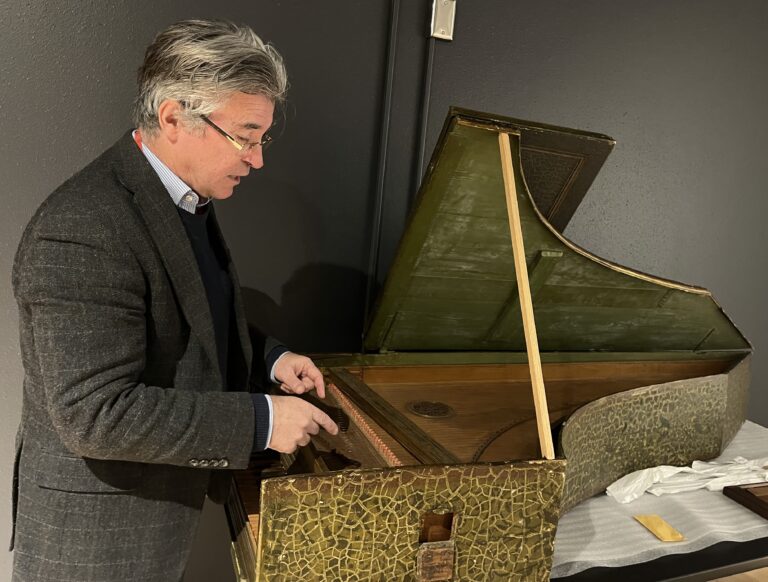The National Music Museum has one of the world’s largest and most significant collections of historical instruments — a sort of musical Smithsonian. But it’s far away from the museums on the national mall. It’s in Vermillion, South Dakota.
During a tour at the National Music Museum, conservator Darryl Martin walked up to one instrument, a small wooden keyboard painted an olive green.
Its lid is propped up, revealing its insides, and Martin plucked a string as he walked by.
“This is actually the oldest playable harpsichord in the world,” he said. “It was made in Naples, probably around about 1525, 1530-ish.”

Five hundred years later, the world’s oldest playable harpsichord has made its way to Vermillion, South Dakota. A town of just under 12,000 tucked into the state’s southeastern tail, it boasts one of the world’s greatest collections of musical instruments.
Dwight Vaught, director at the National Music Museum, knows what you’re thinking.
“Why the National Music Museum is in Vermillion, South Dakota is probably our most asked question,” he said.
Why Vermillion, South Dakota
The story all starts when a man named Arne Larson came to town with his 2,500 instruments, collected during his time as a band and orchestra director at a high school in Brookings, South Dakota.
It was 1966, and the University of South Dakota in Vermillion had hired Larson as a music professor. The new recruit came with a catch.
“When he was hired by the University of South Dakota, he said, ‘Do you have a place that I can store my instruments?’” Vaught said. “And so they offered him a space.”
Larson’s son, André, led the charge to turn the storage space into a museum. He was the first director when the museum officially opened its doors in 1973.
“Both Arne and his son, André, were true forces of nature,” Vaught said. “When you have that visionary mindset, you can sort of block out any of the potential questions or criticisms that might come your way. And today, we’re the benefactors of that focus.”
‘Top three in the world’
André really put the museum on the map in 1984, when he coordinated a $3 million donation to purchase a prestigious collection of early Italian strings that included the world’s oldest cello.

The acquisition – now known as the Witten-Rawlins collection – brought the museum global attention. And confusion.
“All of a sudden then, that did catapult us into people literally around the world saying, ‘Wait a minute, what’s this National Music Museum in Vermillion, South Dakota?’” Vaught said.
André said people would have to make the trek to the Midwest to see the historic instruments. As his father famously said, it’s just as far from New York to Vermillion as it is from Vermillion to New York.
The collection has continued to grow since the early Italian strings acquisition. Fifty years after its founding, the museum boasts 14,000 instruments, covering everything from a clay whistle made as early as 600 AD to one of Elvis’ guitars.
“It’s easily top three in the world,” Martin said. “It’s not just the numbers — it’s the quality of the instruments over a wide range of instrument types.”
One of those instruments took up an entire exhibit room on the museum’s first floor during an early winter visit. It’s an Indonesian gamelan; an ensemble made up of mostly percussion instruments.
On a Thursday afternoon, a group of Vermillion locals assembled in the exhibit room. They removed their shoes and ignored any “do not touch” signs to move the ornate gongs, drums, pots and xylophones that sit across the room.
The Vermillion locals weren’t there to admire the gamelan. They came to play it.
Faythe Weber played the peking, which sort of looks like a small xylophone. She said she learned about gamelan during her trips to Asia while she served in the Navy.
When Weber heard about a gamelan concert in Vermillion, she thought a traveling group was coming through town.

“I was just stunned to learn that the instruments lived here, in Vermillion, and that anyone was welcome to play,” Weber said. Now she’s been with the group for the past ten years. She said the entire museum is an unlikely gem for Vermillion.
“This is one of the best sets of instruments in the world. And it’s here in South Dakota,” she said, laughing. “We’re so lucky.”
A new chapter
The museum reached a significant milestone last year – celebrating its 50th anniversary. It also opened its doors to the public again after a five-year renovation that added a new wing and center for preservation and research.
The accomplishments are partly thanks to the backing of the museum’s regional community, Vaught said.
“If it hadn’t been for the people in Vermillion and all across South Dakota, and even dipping into Nebraska and Iowa, the National Music Museum would not be here today,” he said. “They were the early supporters who spread the word and brought their friends and family.”

Vaught said he likes to re-frame the question of how the National Music Museum made its home in Vermillion.
“It’s not ‘Why did it start here?,’ it’s ‘What does it mean that it stays here?’” he said. “It was a South Dakota product put together by South Dakotans. It was South Dakota bred, South Dakota supported and it will stay here. And that’s a source of pride for us.”
This story was produced in partnership with Harvest Public Media, a collaboration of public media newsrooms in the Midwest. It reports on food systems, agriculture and rural issues.
9(MDM5MjE5NTg1MDE1Mjk1MTM5NjlkMzI1ZQ000))

